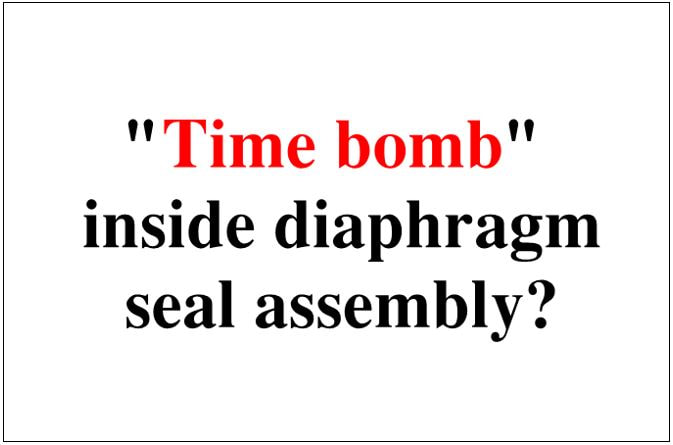"Time bomb" inside your diaphragm seal assembly
We presume that diaphragm seals provide complete isolation from process so the only wetted part to be consider for compatibility with process is diaphragm seal membrane.
Such an engineering judgement can lead to an catastrophic accident especially when dealing with hazardous and flammable substance like hydrocarbons or where the environment is hazardous etc.
The diaphragm membrane seems invincible but due to incorrect material selection or improper understanding of corrosion rate and a variety of other factors, the diaphragm could get eroded/ corroded etc.
Such an engineering judgement can lead to an catastrophic accident especially when dealing with hazardous and flammable substance like hydrocarbons or where the environment is hazardous etc.
The diaphragm membrane seems invincible but due to incorrect material selection or improper understanding of corrosion rate and a variety of other factors, the diaphragm could get eroded/ corroded etc.
When such a scenario occurs the fill fluid inside diaphragm seal would instantly come in contact with the process fluid.
Hence the fill fluid inside diaphragm seal should be compatible with the process.
It is recommended that glycerin or silicone oil (which is a common choice for majority of our application) should not be used with strong oxidizing agents such as oxygen, chlorine, nitric acid or hydrogen-peroxide.
In the presence of such oxidizing agents, potential hazard could result from chemical reaction, ignition, or explosion.
Completely fluorinated or chlorinated fluids, or both, may be more suitable for such applications…….(Reference ASME B40.100-2013 (B40.2) Section 2.8.4)
Also for instance, fill fluids that use hydrocarbon compounds should not be used in oxygen or chlorine service…… (Reference API RP 551 Section 9.2.4 page 199).
For Seals to be used on pharmaceutical or food processing application care should be taken that in worst case scenario if the diaphragm membrane fails, the fill fluid should not contaminate the entire batch or product making it hazardous.
Various standards apply for pharmaceutical or food processing application and must be adhered to by instrument vendor.
Example:- 3A Sanitary standard ……..( ASME B40.100-2013 (B40.2) section 2.8.5)
Special fill fluids are available by vendor for such application like inert oil etc.
Also the fill fluid must be evaluated for it pressure, temperature compatibility.
Conclusively, The Fill fluid of diaphragm seal assembly must be give due importance that it deservers by checking its compatibility with process fluid, environmental conditions, compatibility with pressure and temperature of process.
Otherwise it would be a like a “Time bomb” waiting to react with process fluid or environment and cause significant harm to personal and equipment.
Thanks for reading
Hope its been of valve to you.
To receive such engineering post and relevant job openings “once” every alternate weekend you could jump in to the free newsletter below.
Please note this Newsletter is truly free not just from monetary point of view but also free from any spams or advertisements.
Hence the fill fluid inside diaphragm seal should be compatible with the process.
It is recommended that glycerin or silicone oil (which is a common choice for majority of our application) should not be used with strong oxidizing agents such as oxygen, chlorine, nitric acid or hydrogen-peroxide.
In the presence of such oxidizing agents, potential hazard could result from chemical reaction, ignition, or explosion.
Completely fluorinated or chlorinated fluids, or both, may be more suitable for such applications…….(Reference ASME B40.100-2013 (B40.2) Section 2.8.4)
Also for instance, fill fluids that use hydrocarbon compounds should not be used in oxygen or chlorine service…… (Reference API RP 551 Section 9.2.4 page 199).
For Seals to be used on pharmaceutical or food processing application care should be taken that in worst case scenario if the diaphragm membrane fails, the fill fluid should not contaminate the entire batch or product making it hazardous.
Various standards apply for pharmaceutical or food processing application and must be adhered to by instrument vendor.
Example:- 3A Sanitary standard ……..( ASME B40.100-2013 (B40.2) section 2.8.5)
Special fill fluids are available by vendor for such application like inert oil etc.
Also the fill fluid must be evaluated for it pressure, temperature compatibility.
Conclusively, The Fill fluid of diaphragm seal assembly must be give due importance that it deservers by checking its compatibility with process fluid, environmental conditions, compatibility with pressure and temperature of process.
Otherwise it would be a like a “Time bomb” waiting to react with process fluid or environment and cause significant harm to personal and equipment.
Thanks for reading
Hope its been of valve to you.
To receive such engineering post and relevant job openings “once” every alternate weekend you could jump in to the free newsletter below.
Please note this Newsletter is truly free not just from monetary point of view but also free from any spams or advertisements.







